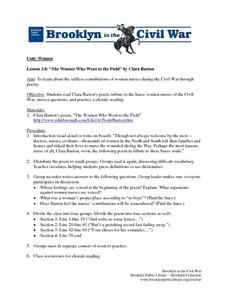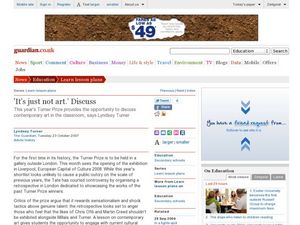Curated OER
Much Ado About Something (Lesson 4)
Students view a film about Shakespeare and his poetry. They complete a worksheet while viewing. They discuss how to properly read a poem and practice reading his sonnets.
Curated OER
Dating - What is Love?
Students explore their feeling on love. They write down their feelings and talk about love and infatuation and what the differences are. Students study the Ladder of Love and write a love poem of their own. They identify the various...
Curated OER
Trees
In this reading and writing worksheet, students analyze a poem about different varieties of trees. Students make a 10 page booklet with each page containing pictures and words about one kind of tree. Students color the book and read the...
Curated OER
"The Women Who Went to the Field"
Students study the selfless contributions of women nurses during the Civil War through poetry. They read Clara Barton's poetic tribute to the brave women nurses of the Civil War, answer questions, and practice a chorale reading.
Curated OER
Spring Activities
In this Spring learning exercise, students read a poem about a butterfly. Students color an illustration and underline rhyming words. Students also write the rhyming words and compose their own Spring poem.
Curated OER
Valentines Day - Elementary
In this ELL worksheet, students match 6 definitions with pictures and then write the word each definition and picture represents. Kids read a passage with pictures in place of missing words and then answer 5 fill in the blank questions...
Curated OER
Similes, Metaphors, and Symbols
Here is an outline of a lesson in which learners examine the use of similes, metaphors, and symbols in poetry. They define similes, metaphors, and symbols, complete a handout, and create a poem using types of figurative language.
Curated OER
The Law and Human Rights
Students read and discuss the poem, Like You. They simulate a space colony and list what they consider to be the three most important human rights. They compare their space colony rights to those of the Universal Declaration of Human...
National Endowment for the Humanities
A Raisin in the Sun: Whose "American Dream"?
How does Lorraine Hansberry's A Raisin in the Sun factor into a discussion of the American dream? High schoolers define the American dream and recognize the historical setting of the play. Additionally, they identify...
Curated OER
Genre
In this genre study PowerPoint presentation, students read the definitions and characteristics of each literary genre. There are 17 genres that the PowerPoint presentation addresses, such as science fiction, tall tales and poetry.
Curated OER
What is a Hero? Heroism in Greek Mythology
Students explore the tales of Greek mythology and discuss what it means to be a hero. They associate acts of epic heroism with philanthropy noting that these characters acted in a larger than life manner to secure the common good.
Curated OER
Understanding Character
Learners are introduced to literary elements and definitions in the worksheet Understanding Character but reading through each of the elements and definitions aloud. They read the story, "La Bamba" and identify examples of the literary...
Curated OER
It's Just Not Art
Students examine multiple styles of artwork that have earned awards. In this art lesson, students discuss the definition of contemporary art then compare how artwork has changed over the years.
Pennsylvania Department of Education
Comparing Key Ideas and Details in Fiction and Nonfiction
Students recognize the differences between fiction and nonfiction texts. In this genre study lesson, students discuss what nonfiction means and write the definition. Students listen to a read aloud and vote whether the text is fiction or...
Curated OER
English Exercises: Mysteries of Anatomy
Consider this online interactive activity as a way to practice the names that often accompany human anatomy, such as the crown of the head and the roof of the mouth. Learners select an anatomy word with a double meaning from a drop-down...
Curated OER
Emotion Similes
Students define what a simile is before writing a poem that is based primarily on similes. They brainstorm and write the poem using the give format. They write drafts, revise and present a final poem.
Curated OER
Analytical Essay
What is an analytical essay? Introduce this type of thinking to your young writers. First, discuss what it means to analyze something. Then, identify the different components of an essay and what details are embedded in each component....
Curated OER
Blank Verse and Iambic Pentameter
Shakespeare's use of language is the focus of this short PowerPoint. Each of the three slides describes one way he chose to write his plays: in iambic pentameter, and in couplets. The final slide describes a sonnet, which is a lyric poem...
Curated OER
Looking for Newton
Students discuss the rhyming pattern of various types of poetry. With a focus on limericks, they follow the specific rhyme scheme and create a limerick about Newton. They share their poem with the class and write another one related to...
Curated OER
The Odyssey Lesson 6
"How are belief systems represented and reproduced through nature?" This essential question guides lesson 6 of this unit on The Odyssey (the rest of the unit is linked). Students first write about a scenario in which they are...
Curated OER
Limericks
The teaching of how to write limericks is the focus of this presentation. Learners see verses such as: "There was an old man from Blackneath, Who sat down on his set of false teeth. He said, in his pain, 'I've done it again, I've bitten...
Channel Islands Film
Dark Water: Lesson Plan 3 - Grades 6-12
After watching the documentary Dark Water about a traditional Chumash ceremony and reading a Chumash origin story, viewers are asked to create a coat of arms and to craft an essay that details a family tradition or their own origin story.
Scholastic
Identifying Types of Irony Using "The Gift of the Magi"
O. Henry's "The Gift of the Magi" is the classic example of irony in literature. Teach young writers about the ways irony can engage their readers with an activity in which they write scripts using dramatic irony, situational irony, and...
Curated OER
Language Arts: Creative Writing Devices
Eighth graders review sound and rhythm devices and apply them to their own writing exercises. Next, they interpret the poem, "Where I'm From," as an example of a personal narrative. Using their understanding of poetic devices, they...

























